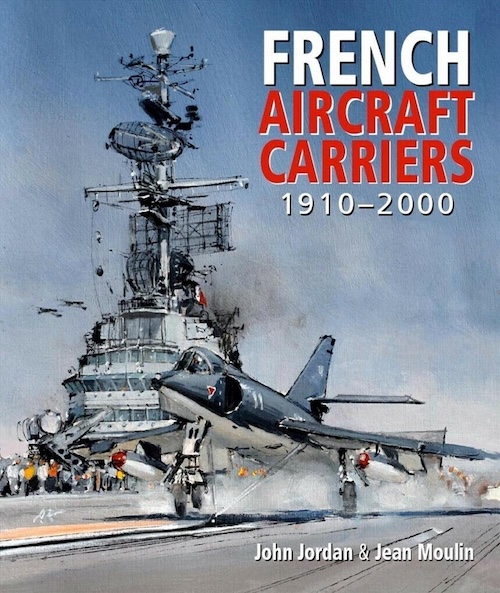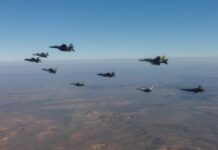
French Aircraft Carriers 1910 – 2000. By John Jordan & Jean Moulin. Seaforth Publishing, Barnsley, 2025. ISBN 978-1-0361-2453-3 (Hardback) ISBN 978-1-0361-2454-0 (ePub).
Reviewed by David Hobbs
This excellent book adds a significant new dimension to the historiography of aircraft carrier design, development and operations with two authors who are ideally suited to the task. John Jordan has a background in teaching languages but will be known to many ANI members as the editor of the annual Warship from 2005 onwards.
He has already co-authored three authoritative works for Seaforth Publishing on warships of the Marine Nationale; French Battleships 1922-1956 with Robert Dumas, French Cruisers 1922-1956 with Jean Moulin and French Destroyers 1922-1956, also with Jean Moulin. His co-author Jean Moulin is a former French naval IT technician who has written widely about the Marine Nationale in addition to his collaboration with John Jordan.
The book is extremely well illustrated with 246 carefully-chosen photographs; some of the later examples being in colour, over 200 technical drawings and 10 maps, all drawn by the two authors. At this point I must confess that I provided 7 photographs of comparable RN aircraft carriers and read through part of the chapter on early steps at John Jordan’s request but I had no other input to the creation of this book for which all credit is due to the authors. The ships described include the seaplane carrier Commandant Teste and several early seaplane carriers as well as the various through-deck, fixed-wing aircraft carriers that have served with the French Navy. A significant amount of space is also devoted to the various aircraft carrier studies that reached the project definition and design stages but which did not enter service. These include Joffre which was laid down but abandoned and scrapped on the slipway after the French collapse in June 1940. The book is laid out logically with succeeding chapters covering each class of ship or project design, each of which describes the design and the drawings enhance the text with details ranging from general arrangements, through machinery layout and protection to the specific radar arrays on the islands of the later ships at various stages during their careers. Different methods of aircraft operation including visual landing aids that were unique to the French Navy are described with drawings to add clarity. The second part of each chapter comprises a detailed operational history of the ships including the aircraft types that flew from them, operations carried out and changes made in their various refits and modernisations. Aircraft operated by the Aeronavale from carriers are described with their own text, drawings and technical specifications.
Some potential readers might think, at first glance, that this book has little relevance to the RAN but this is not the case. One of the French aircraft carriers was the former HMS Colossus, one of the ubiquitous RN 1942-design light fleet carriers, a group that also included the Australian Sydney, Vengeance and the much-modified Melbourne. Colossus became Arromanches after transfer and her affordable modernisation with an angled flight deck shows what could have been achieved with Sydney. As far as I am aware she is the only aircraft carrier to have been fitted with separate arrester wire systems aligned with both the axial deck to operate piston-engined fighters and the angled deck to operate jets. The Aeronavale also operated a licence-built version of the de Havilland Sea Venom known in service as the Aquilon; a type that served with distinction with the RAN and was, for some, years the only radar-equipped all-weather fighter operated in the Southern Hemisphere. Apart from these similarities, the French Navy has always had its own distinctive view on aircraft carrier design and the methods used to launch and recover aircraft from them. The authors make frequent comparison with those of the US, Royal and Imperial Japanese Navies but they are just as pertinent to the RAN. I found the text stimulating and enjoyed widening my view of naval aviation by studying it from another navy’s viewpoint and I am sure that other readers would feel the same.
After early misgivings about the role and value of carriers, including several studies into the kind of hybrid cruiser/carriers that the USN considered but rejected in the early 1930s, the French Navy has maintained a steadfast line on carrier design, construction and use, gaining the best value from its tightly-limited budget. Today it is the only navy, other than the USN, to operate a nuclear-powered aircraft carrier and its Rafale M fighters are world class. The first metal has been cut for a replacement nuclear-powered carrier to be laid down in early 2026. Designated PA-Ng, porte-avions nouvelle generation, it is to have three electromagnetic catapults together with advanced arrester gear, both procured from the USA. The Aeronavale shows what can be achieved in a country where the Fleet Air Arm is highly regarded and enabled to operate properly trained and equipped naval aircraft, especially fighters, to operate from aircraft carriers at the time and place of the nation’s choosing, something no land-locked air force can ever do.
The French Navy’s current carrier, Charles de Gaulle, has its development and design fully described within the relevant chapter but, unlike the previous ships, its operational history is not included. This is because she is still in commission with more than an a decade to run and any description would be incomplete and out-dated by the date of publication. It was, therefore, a wise decision to end the text in 2000 so that it covers a finite period. Hopefully there will be a second volume one day that will include it.
It would be difficult to imagine a better book from either the technical or operational viewpoints and it is likely to remain the definitive work on the subject until PA-Ng becomes a reality and Charles de Gaulle’s career has ended. Besides giving a fascinating insight into this important subject, French Aircraft Carriers is beautifully presented and written in a very readable style. It is a credit to both authors and to Seaforth Publishing and I recommend it highly.



